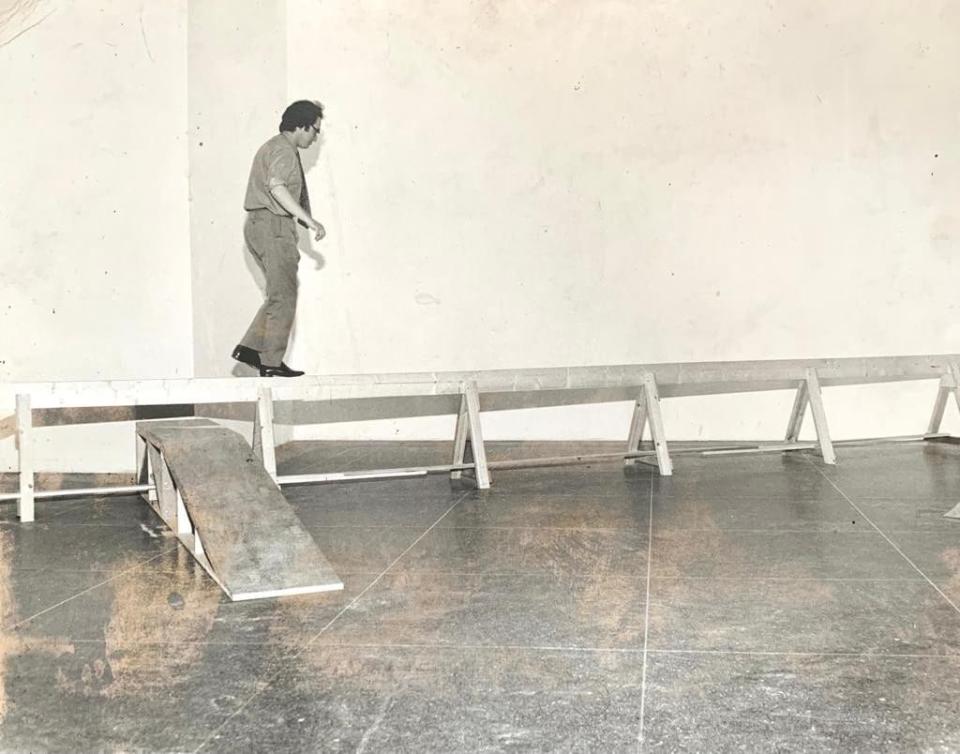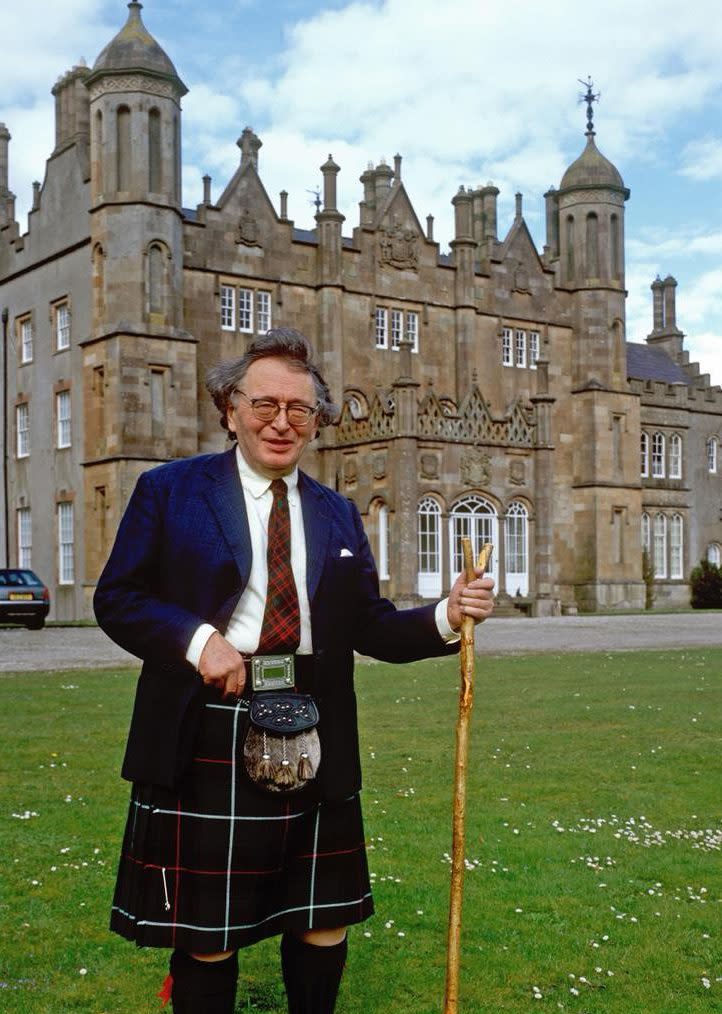The Earl of Antrim, authority on art who served as Keeper of Conservation at the Tate Gallery for 20 years – obituary

- Oops!Something went wrong.Please try again later.
The 14th Earl of Antrim, who has died aged 86, was an acknowledged expert on many aspects of art and a leading authority on the restoration of paintings.
As Keeper of Conservation at the Tate Gallery in London from 1975 to 1995, the shy, self-effacing and somewhat unorthodox Alexander Dunluce (as he was known professionally) said that the greatest compliment for a restorer was to have their work not noticed.
It was fortunate, therefore, that in 2011 he made a rich and detailed audio recording for the National Life Stories series at the British Library. His testimony, told with patience and humour (and the squeaking of the chair on which he habitually sat in his studio), described his training with the famous and occasionally controversial conservator Helmut Ruhemann, and his establishment of the firm Dunluce Rothenstein Ltd with his friend Lucy Rothenstein, who was well connected in the art world via her father John Rothenstein, Director of the Tate.

Dunluce’s account of his time with the Tate’s conservation team charted the evolution of the department under the successive leaderships of Norman Reid, Alan Bowness and Nicholas Serota. Besides running his department during a period of great change and expansion at the Tate – the Clore Gallery housing the Turner bequest opened in 1987, Tate Liverpool in 1988 and Tate St Ives in 1993 – Dunluce carried on with his work as a highly dexterous, sensitive and innovative painting restorer.
He was among the first to use the acrylic resin Paraloid-B72, a sample of which he brought over from America and introduced to Ruhemann as a retouching medium. Ruhemann deemed it “the fulfilment of the restorer’s dream: a paint that will stay put, with which one can match a tone, and will not change either in drying or varnishing or with time.”

Dunluce was in his element treating works by British masters such as Turner and Joseph Wright of Derby, with whom he had a particular affinity. Among his most painstaking and successful restorations was of Wright’s An Experiment on a Bird in the Air Pump, and he was not especially happy when the National Gallery reclaimed it from the Tate in 1986.
Around the same time he rescued Wright of Derby’s Vesuvius in Eruption from the attic at Glenarm Castle, his family home in Northern Ireland, where it had languished for several decades after being badly damaged by smoke during a fire. Beautifully restored by Dunluce, it was eventually acquired by the Tate, enabling him to repair Glenarm’s leaky roof, restore a cottage for himself and his second wife and buy two old Lagondas, vintage cars being another of his passions.
Alexander Randal Mark McDonnell was born in London on February 3 1935, the eldest of three surviving children of the 13th Earl of Antrim, later an energetic chairman of the National Trust who also launched Enterprise Neptune to help preserve the British coastline. Alexander’s grandfather had died before he was born, so he was Viscount Dunluce from birth.

Alexander’s mother Angela (daughter of Sir Mark Sykes of Sledmere) was a talented professional sculptor, cartoonist and illustrator who redecorated Glenarm with her painted interpretations of McDonnell family history and classical mythology, as well as sculpting the nine planets as caryatids in the hall.
The McDonnells were Catholic Highland Scots who fared well during the Ulster plantation period under the leadership of their warrior-like chieftain Sorley Boy McDonnell, whose son was created Earl of Antrim in 1620. Their estates once extended to some 330,000 acres, but were later vastly reduced by gambling and the Irish Land Acts.
On the outbreak of war, Alexander’s mother took the children to Glenarm, where Alexander ran riot with the gardener’s son Jackie Wilson, whose nickname for him of “Lordie” stuck throughout their lifelong friendship. When Jackie (later a successful retailer but before that a lorry driver) married, the local paper ran the headline “Viscount Attends Lorry Driver’s Wedding”.

Hampered by dyslexia, Dunluce failed to get into Eton (he ruefully recalled spelling its name “Eaton” on his entrance paper) and instead went to Downside, where he was teased for having a title, with Dunluce variously morphing into such names as “Dumbo” and “Loo Seat”.
He went on to read History at Christ Church, Oxford, where his tutor was Hugh Trevor-Roper, but soon transferred to the Ruskin School of Art, while sharing a house with Thomas Pakenham, Mark Girouard and Alexander Weymouth (later Lord Bath).
His Ruskin contemporaries included Ron Kitaj, and he was taught by Lawrence Toynbee. Lucy Rothenstein was in the year ahead and at that time the girlfriend of Jeremy Sandford. When she later went on to study conservation and restoration with Helmut Ruhemann, Dunluce watched her at work with growing interest. Already doubtful about making painting his career, he eventually decided to follow the same path.

After his father made over Glenarm to him, he moved back to Northern Ireland in 1969, combining running the estate with working as a conservator in the Ulster Museum in Belfast. But the worsening Troubles soon took him back to London, where he resumed work at the Tate in 1971 and succeeded Stefan Slabcynski as Keeper of Conservation four years later.
The new galleries at the Tate were accompanied by expanding programmes of exhibitions, loans and acquisitions, and Dunluce relished all these challenges as well as the occasional overseas adventures they afforded. He also became head of Collection Services in 1990 and was later involved in the planning for Tate Modern.
Calm, thoughtful, gentle and kind, with a pronounced spontaneous sense of fun, he excelled as a mentor to young conservators, ever willing to share his expertise and enthusiasm while also providing inspiration by continuing with his own subtly observed paintings of his native glens in Northern Ireland, many of his works done on old cigar boxes, of which he had an endless supply from his father-in-law.

Slightly absent-minded and casual in appearance, he would often forget to take his bicycle clips off before attending stuffy board meetings and would turn up at his daughters’ speech day in a safari suit and trainers.
When he retired from the Tate on his 60th birthday he was given a folding Brompton bike and he impulsively jumped on to it and rode around the Duveen Gallery a few times with a mischievous grin.
Having finally taken the title of Earl of Antrim – he decided to do so with the toss of a coin – he subsequently threw his energies into such interests as the Fishmongers’ Company, Ulster Television and the Northern Salmon Company, having earlier made Glenarm over to his son Randal.
He married first, in 1963, Sarah Harmsworth; they had a son and two daughters. That marriage was dissolved in 1974. He married secondly, in 1977, Elizabeth Sacher; they had a daughter. He is succeeded in the earldom by his son.
The Earl of Antrim, born February 3 1935, died July 21 2021

